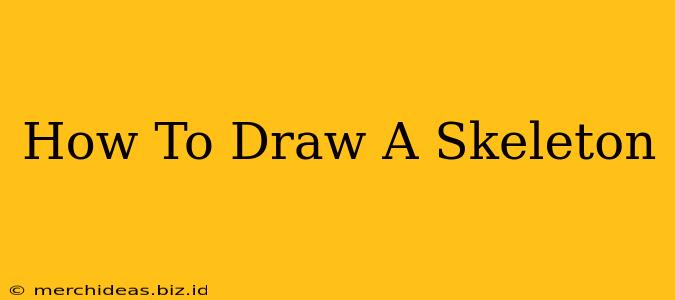Drawing a skeleton might seem daunting, but with a little practice and the right approach, you can create a surprisingly realistic—or delightfully spooky—representation of the human skeletal system. This guide will walk you through the process, from basic shapes to adding detail and personality. Whether you're a beginner picking up a pencil for the first time or an experienced artist looking to refine your technique, you'll find helpful tips and tricks here.
Understanding the Basic Structure: The Foundation of Your Skeleton Drawing
Before diving into the details, let's establish a solid foundation. The human skeleton, while complex, can be broken down into simpler forms. Think of it as a construction project; you wouldn't start building a house without a blueprint!
Step 1: The Simple Shapes
Start by sketching basic shapes to represent the major parts of the skeleton:
- Skull: Begin with a circle for the cranium, then add smaller shapes for the jaw and eye sockets. Don't worry about perfect proportions just yet; we'll refine those later.
- Rib Cage: Use an oval shape for the rib cage, slightly wider at the bottom than the top.
- Spine: A gently curving vertical line forms the backbone.
- Pelvis: A roughly upside-down trapezoid will serve as the foundation for the pelvis.
- Limbs: Use long cylinders for the long bones of the arms and legs. Remember that the arms are slightly shorter than the legs.
Step 2: Connecting the Shapes
Once you have your basic shapes, begin connecting them. The spine connects the skull, rib cage, and pelvis. The arms and legs attach to the rib cage and pelvis, respectively. Don't worry if your initial connections are a little rough; this is just a framework.
Adding Detail and Anatomy: Refining Your Skeleton Drawing
Now that you have the fundamental structure in place, it's time to add details and refine the proportions. This is where anatomical accuracy (or artistic interpretation, depending on your goal) comes into play.
Step 3: Refining the Skull
The skull is a complex structure. Add details such as the nasal cavity, the eye sockets, and the jawline. You can find numerous reference images online or in anatomy books for accurate representation. Remember to consider the perspective; a skull viewed from the side will look different from one viewed from the front.
Step 4: Defining the Rib Cage and Spine
The rib cage is composed of individual ribs, which you can now sketch in. Pay attention to their curvature and how they attach to the sternum (breastbone). The spine should show a subtle S-curve, and you can add detail to the individual vertebrae (though this is optional depending on your desired level of detail).
Step 5: Adding the Limbs and Hands/Feet
Break down the cylinders representing the limbs into individual bones. The arms have the humerus (upper arm), radius, and ulna (forearm). The legs have the femur (thighbone), tibia, and fibula (lower leg). Sketch in the smaller bones of the hands and feet.
Step 6: Adding Joints
Finally, indicate the joints where the bones meet. Use small circles or slightly overlapping shapes to suggest the articulation of the bones.
Tips for Drawing Realistic Skeletons: Mastering the Nuances
- Use References: Reference images are invaluable. Study anatomical charts or skeletons to understand bone structure and proportions.
- Light and Shadow: Adding shading can greatly enhance the three-dimensionality of your drawing. Pay attention to where the light source is hitting the bones and how it creates shadows.
- Practice Makes Perfect: The more you practice, the better you'll become. Don't be discouraged if your first attempts aren't perfect.
- Experiment with Styles: Don't be afraid to experiment with different styles—from realistic anatomical drawings to more stylized or cartoonish representations.
Beyond the Basics: Exploring Creative Variations
Once you've mastered the basics, you can explore different artistic directions:
- Spooky Skeletons: Add a mischievous grin or glowing eyes to your skeleton for a Halloween-themed drawing.
- Anatomical Studies: Create detailed drawings focusing on specific bone structures.
- Dynamic Poses: Draw your skeleton in action poses to add dynamism to your artwork.
Drawing a skeleton is a rewarding process that allows you to combine artistic skill with anatomical understanding. Follow these steps, practice diligently, and you'll be surprised at the results you can achieve. Remember to have fun and let your creativity shine through!
